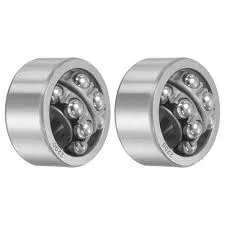
Nov . 08, 2024 18:02 Back to list
6203 bearing ball size
Understanding the 6203 Bearing Ball Size and Specifications
Bearings are critical components in various mechanical systems, enabling smooth rotation and significantly reducing friction between moving parts. Among the many types of bearings available today, the 6203 bearing stands out due to its versatility and widespread application in different industries. This article delves into the specifications, dimensions, and importance of the ball size in 6203 bearings.
What is a 6203 Bearing?
The 6203 bearing is part of the deep groove ball bearing family, which is known for its ability to accommodate both radial and axial loads. This makes it an ideal choice for a diverse range of applications, including electric motors, automotive components, industrial machinery, and household appliances. The 6203 designation refers specifically to the bearing’s size and features according to the International Organization for Standardization (ISO) standards.
Dimensions of the 6203 Bearing
The 6203 bearing has well-defined dimensions that contribute to its functionality. It typically has the following measurements
- Inner Diameter (ID) 17 mm - Outer Diameter (OD) 40 mm - Width (B) 12 mm
These dimensions are critical because they determine how the bearing fits into a specific housing or shaft. When selecting a bearing, it’s crucial to ensure that the dimensions match the application requirements to avoid operational failures.
Ball Size in the 6203 Bearing
One of the essential aspects of the 6203 bearing is the size of the balls used in its construction. The balls within a bearing play a fundamental role in bearing performance and longevity. In a 6203 bearing, the balls typically have a diameter of 7 mm. This size is optimized to balance load capacity with the need for smooth operation.
The ball size influences several factors
6203 bearing ball size

1. Load Capacity The diameter and material of the balls directly impact the bearing's load capacity. Larger balls can generally carry more load; however, they also require more space. The 7 mm diameter of the 6203 strikes a balance, ensuring adequate load distribution while fitting within the compact dimensions of the bearing.
2. Friction and Wear The material and smoothness of the balls contribute to the friction levels within the bearing. High-quality steel balls, which are common in 6203 bearing designs, provide smooth operation and reduced wear. The polished surface of the balls minimizes friction, enhancing the bearing's efficiency.
3. Heat Generation As bearings operate, heat generated from friction can impact performance. The size and arrangement of the balls play a role in heat dissipation. The 6203 bearing's design helps maintain lower operational temperatures, contributing to a longer service life.
Applications of the 6203 Bearing
Given its dimensions and characteristics, the 6203 bearing is used in a variety of applications. You can find them in
- Electric Motors They are commonly used in appliance motors due to their ability to handle radial and axial loads effectively. - Automotive Components The 6203 bearing is utilized in various automotive applications, such as in wheel hubs or engine components, where durability and reliability are crucial.
- Industrial Equipment These bearings form a vital part of conveyors, pumps, and compressors, where smooth operation is paramount.
- Household Appliances From washing machines to fans, the 6203 bearing's capability to operate quietly and efficiently makes it a popular choice.
Conclusion
The 6203 bearing is a fundamental component in many mechanical systems. Its specifications, particularly the ball size of 7 mm, play a pivotal role in determining the bearing's load capacity, friction levels, and overall performance. Understanding these aspects is crucial for engineers and manufacturers who depend on reliable bearings for their applications. As industries continue to evolve, the demand for high-quality bearings like the 6203 will remain significant, ensuring smooth and efficient operations in a wide array of machinery.
Latest news
-
Grooved Ball Bearing Design and Functionality
NewsJun.04,2025
-
Concrete Mixer Bearing Load Capacity Testing
NewsJun.04,2025
-
6004 Bearing Dimensions in Robotic Joint Designs
NewsJun.04,2025
-
Advantages of Single-Row Deep Groove Ball Bearings
NewsJun.04,2025
-
Applications of Deep Groove Ball Bearings in Automotive Systems
NewsJun.04,2025
-
Innovations in Bearing Pressing Machine Design
NewsJun.04,2025
